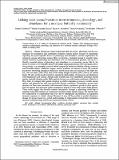Por favor, use este identificador para citar o enlazar a este item:
http://hdl.handle.net/10261/235650COMPARTIR / EXPORTAR:
 SHARE SHARE
 CORE
BASE CORE
BASE
|
|
| Visualizar otros formatos: MARC | Dublin Core | RDF | ORE | MODS | METS | DIDL | DATACITE | |

| Título: | Linking inter-annual variation in environment, phenology, and abundance for a montane butterfly community |
Autor: | Stewart. James E.; Gutiérrez IIlán, Javier; Richards, Shane A.; Gutiérrez, David; Wilson, Robert J. CSIC ORCID | Fecha de publicación: | 2020 | Editor: | Ecological Society of America | Citación: | Ecology - Ecological Society of America 101(1): e02906 (2020) | Resumen: | Climate change has caused widespread shifts in species¿ phenology, but the consequences for population and community dynamics remain unclear because of uncertainty regarding the species¿specific drivers of phenology and abundance, and the implications for synchrony among interacting species. Here, we develop a statistical model to quantify inter¿annual variation in phenology and abundance over an environmental gradient, and use it to identify potential drivers of phenology and abundance in co¿occurring species. We fit the model to counts of 10 butterfly species with single annual generations over a mountain elevation gradient, as an exemplar system in which temporally limited availability of biotic resources and favorable abiotic conditions impose narrow windows of seasonal activity. We estimate parameters describing changes in abundance, and the peak time and duration of the flight period, over ten years (2004¿2013) and across twenty sample locations (930¿2,050 m) in central Spain. We also use the model outputs to investigate relationships of phenology and abundance with temperature and rainfall. Annual shifts in phenology were remarkably consistent among species, typically showing earlier flight periods during years with warm conditions in March or May¿June. In contrast, inter¿annual variation in relative abundance was more variable among species, and generally less well associated with climatic conditions. Nevertheless, warmer temperatures in June were associated with increased relative population growth in three species, and five species had increased relative population growth in years with earlier flight periods. These results suggest that broadly coherent interspecific changes to phenology could help to maintain temporal synchrony in community dynamics under climate change, but that the relative composition of communities may vary due to interspecific inconsistency in population dynamic responses to climate change. However, it may still be possible to predict abundance change for species based on a robust understanding of relationships between their population dynamics and phenology, and the environmental drivers of both. | Descripción: | This is an open access article under the terms of the Creative Commons Attribution License, which permits use, distribution and reproduction in any medium, provided the original work is properly cited. | Versión del editor: | http://dx.doi.org/10.1002/ecy.2906 | URI: | http://hdl.handle.net/10261/235650 | DOI: | 10.1002/ecy.2906 | Identificadores: | doi: 10.1002/ecy.2906 issn: 1939-9170 |
| Aparece en las colecciones: | (MNCN) Artículos |
Ficheros en este ítem:
| Fichero | Descripción | Tamaño | Formato | |
|---|---|---|---|---|
| WilsonRJ_Linking inter_annual.pdf | 1,05 MB | Adobe PDF |  Visualizar/Abrir |
CORE Recommender
Page view(s)
104
checked on 30-abr-2024
Download(s)
70
checked on 30-abr-2024
Google ScholarTM
Check
Altmetric
Altmetric
NOTA: Los ítems de Digital.CSIC están protegidos por copyright, con todos los derechos reservados, a menos que se indique lo contrario.
